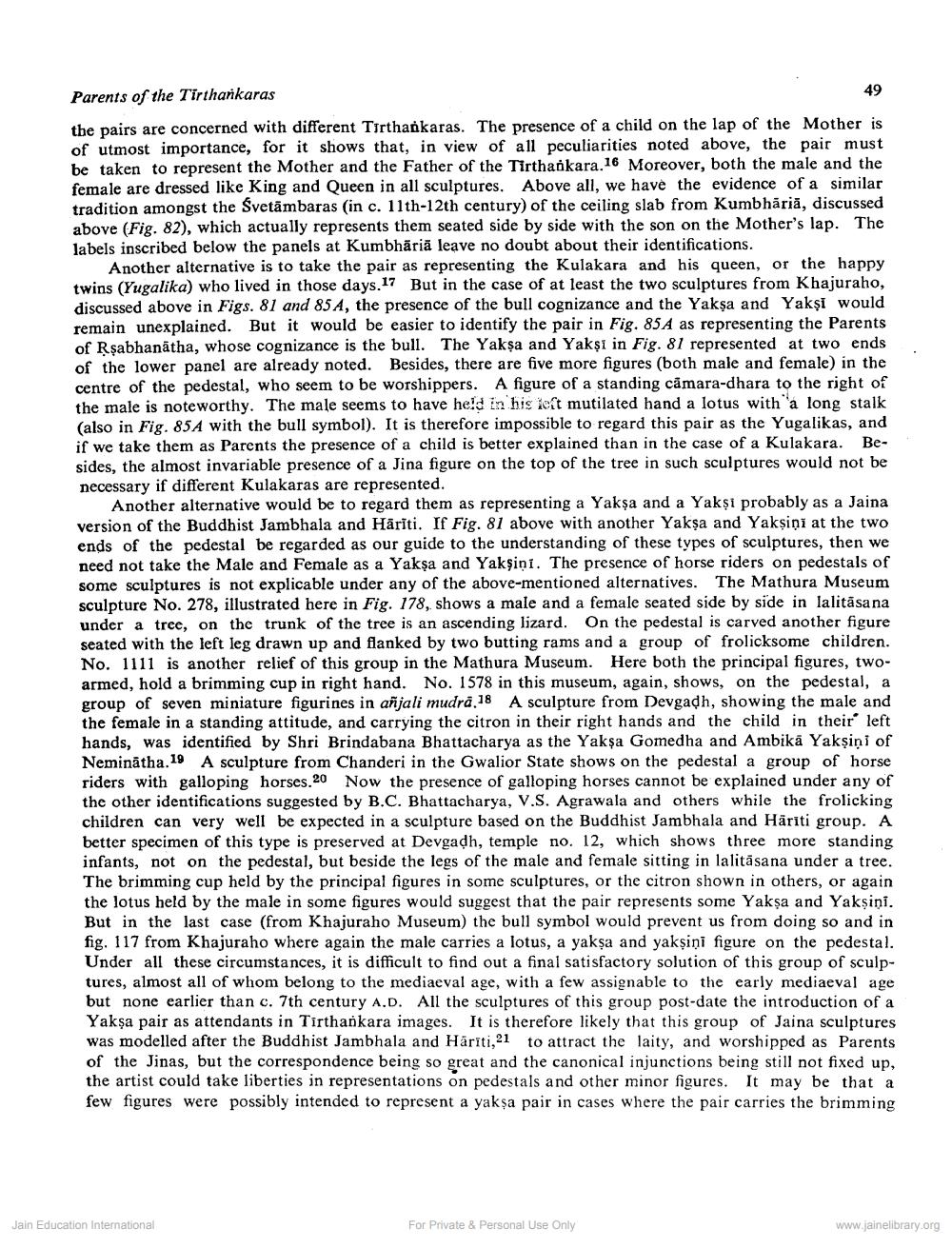________________
Parents of the Tirtharkaras
49
the pairs are concerned with different Tirthankaras. The presence of a child on the lap of the Mother is of utmost importance, for it shows that, in view of all peculiarities noted above, the pair must be taken to represent the Mother and the Father of the Tirtharkara.16 Moreover, both the male and the female are dressed like King and Queen in all sculptures. Above all, we have the evidence of a similar tradition amongst the Svetāmbaras (in c. 11th-12th century) of the ceiling slab from Kumbharia, discussed above (Fig. 82), which actually represents them seated side by side with the son on the Mother's lap. The labels inscribed below the panels at Kumbhāriā leave no doubt about their identifications.
Another alternative is to take the pair as representing the Kulakara and his queen, or the happy twins (Yugalika) who lived in those days.17 But in the case of at least the two sculptures from Khajuraho, discussed above in Figs. 81 and 85 A, the presence of the bull cognizance and the Yaksa and Yaksi would remain unexplained. But it would be easier to identify the pair in Fig. 85 A as representing the Parents of Rsabhanatha, whose cognizance is the bull. The Yaksa and Yaksi in Fig. 81 represented at two ends of the lower panel are already noted. Besides, there are five more figures (both male and female) in the centre of the pedestal, who seem to be worshippers. A figure of a standing camara-dhara to the right of the male is noteworthy. The male seems to have held in his left mutilated hand a lotus with a long stalk (also in Fig. 85 A with the bull symbol). It is therefore impossible to regard this pair as the Yugalikas, and if we take them as Parents the presence of a child is better explained than in the case of a Kulakara. Besides, the almost invariable presence of a Jina figure on the top of the tree in such sculptures would not be necessary if different Kulakaras are represented.
Another alternative would be to regard them as representing a Yakşa and a Yakşi probably as a Jaina version of the Buddhist Jambhala and Häriti. If Fig. 81 above with another Yakşa and Yaksini at the two ends of the pedestal be regarded as our guide to the understanding of these types of sculptures, then we need not take the Male and Female as a Yakşa and Yakşiņi. The presence of horse riders on pedestals of some sculptures is not explicable under any of the above-mentioned alternatives. The Mathura Museum sculpture No. 278, illustrated here in Fig. 178, shows a male and a female seated side by side in lalitása na under a tree, on the trunk of the tree is an ascending lizard. On the pedestal is carved another figure seated with the left leg drawn up and flanked by two butting rams and a group of frolicksome children. No. 1111 is another relief of this group in the Mathura Museum. Here both the principal figures, twoarmed, hold a brimming cup in right hand. No. 1578 in this museum, again, shows, on the pedestal, a group of seven miniature figurines in añjali mudrā.18 A sculpture from Devgadh, showing the male and the female in a standing attitude, and carrying the citron in their right hands and the child in their left hands, was identified by Shri Brindabana Bhattacharya as the Yaksa Gomedha and Ambika Yakşini of Neminātha. 19 A sculpture from Chanderi in the Gwalior State shows on the pedestal a group of horse riders with galloping horses. 20 Now the presence of galloping horses cannot be explained under any of the other identifications suggested by B.C. Bhattacharya, V.S. Agrawala and others while the frolicking children can very well be expected in a sculpture based on the Buddhist Jambhala and Härīti group. A better specimen of this type is preserved at Devgadh, temple no. 12, which shows three more standing infants, not on the pedestal, but beside the legs of the male and female sitting in lalitäsana under a tree. The brimming cup held by the principal figures in some sculptures, or the citron shown in others, or again the lotus held by the male in some figures would suggest that the pair represents some Yaksa and Yakşini. But in the last case (from Khajuraho Museum) the bull symbol would prevent us from doing so and in fig. 117 from Khajuraho where again the male carries a lotus, a yakşa and yaksini figure on the pedestal. Under all these circumstances, it is difficult to find out a final satisfactory solution of this group of sculptures, almost all of whom belong to the mediaeval age, with a few assignable to the early mediaeval age but none earlier than c. 7th century A.D. All the sculptures of this group post-date the introduction of a Yaksa pair as attendants in Tirthankara images. It is therefore likely that this group of Jaina sculptures was modelled after the Buddhist Jambhala and Häriti,21 to attract the laity, and worshipped as Parents of the Jinas, but the correspondence being so great and the canonical injunctions being still not fixed up, the artist could take liberties in representations on pedestals and other minor figures. It may be that a few figures were possibly intended to represent a yaksa pair in cases where the pair carries the brimming
Jain Education International
For Private & Personal Use Only
www.jainelibrary.org




